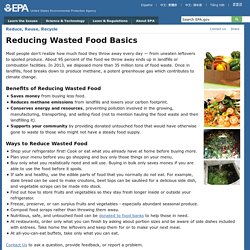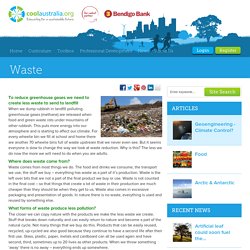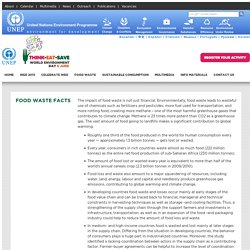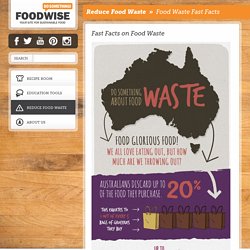

How can I stop food waste? Reducing Wasted Food Basics. Most people don't realize how much food they throw away every day — from uneaten leftovers to spoiled produce.

About 95 percent of the food we throw away ends up in landfills or combustion facilities. Top tips to avoid food waste - Love Food Hate Waste. The State of Waste – Australian Food Wastage Stats. The 15 most wasted foods in the country - and how to avoid wasting them! Cool Australia. To reduce greenhouse gases we need to create less waste to send to landfill When we dump rubbish in landfill polluting greenhouse gases (methane) are released when food and green waste rots under mountains of other rubbish.

This puts more energy into our atmosphere and is starting to affect our climate. For every wheelie bin we fill at school and home there are another 70 wheelie bins full of waste upstream that we never even see. But it seems everyone is slow to change the way we look at waste reduction. Effects of food waste - DOWN TO EARTH. World Environment Day - Food Waste Facts. The impact of food waste is not just financial.

Environmentally, food waste leads to wasteful use of chemicals such as fertilizers and pesticides; more fuel used for transportation; and more rotting food, creating more methane – one of the most harmful greenhouse gases that contributes to climate change. Methane is 23 times more potent than CO2 as a greenhouse gas. The vast amount of food going to landfills makes a significant contribution to global warming. Roughly one third of the food produced in the world for human consumption every year — approximately 1.3 billion tonnes — gets lost or wasted. Facts. Goodtoknow.co. FOODWISE. Bread is one of Australia’s most wasted kitchen foods.

As the basis of many day-to-day meals and with a limited used-by date, it’s easy to see why. 17 countries that waste most food. Last updated on: October 20, 2011 09:32 IST While millions are struggling to put two meals on the table and thousands are starving in Africa and in some Indian states, there are people, primarily in the developed world, who continue to waste tonnes of food every day.

So, on the one hand, there are children who are dying because they do not have anything to eat, while, on the other hand, there are people who have so much that they simply throw away a good part of it. Let us have a look at how much food is wasted in 17 countries, based on OECD Environmental Data Compendium. Click NEXT to read more... Image: Waste generation is becoming a big problem. 1. Food wasted by Americans: 760 kilogrammes per person per year. Click NEXT to read more... Image: A view of New York City. 2. Food wasted by Australians: 690 kilogrammes per person per year. Image: A view of Perth. Food Waste Fast Facts. The following data was used by Do Something!

To calculate the new national food waste figure of $8 billion: To better understand community knowledge, attitudes and behaviours about household food waste, 1,200 NSW households were surveyed as part of the ‘Food Waste Avoidance Benchmark Study’. This NSW Government study was the most comprehensive analysis of community knowledge, attitudes and behaviours yet conducted in Australia about food waste. As a result of this study, NSW Government stats from ‘Love Food Hate Waste’ estimate that the average NSW household throws out $1,036 of food every year. Do Something! In NSW, food waste also makes up to 38% of the total rubbish in household garbage bins. Given the national consistency that we found on food waste levels across Australia, we arrived at the $8 billion figure by extrapolation. 7,760,320 populated households multiplied by $1,036 is $8.04 billion.
Food-Waste-Infographic-537x345.png (PNG Image, 537 × 345 pixels) Food Waste: The Facts - World Food Day. When we scrape off our dishes after a large meal, too full to finish the remaining scraps on our plate, we rarely pause and think about the significance of our action.

It seems routine to us: if we have leftover food scraps that are unfit for eating, shouldn’t they be thrown in the garbage? Our routine practices, unfortunately, make it difficult for us to conceptualize the magnitude of global food waste. The problem is bigger than we think. According to a recent report by UNEP and the World Resources Institute (WRI), about one-third of all food produced worldwide, worth around US$1 trillion, gets lost or wasted in food production and consumption systems. When this figure is converted to calories, this means that about 1 in 4 calories intended for consumption is never actually eaten. Let’s start with some basic statistics about food waste in North America and around the world.